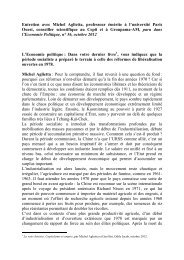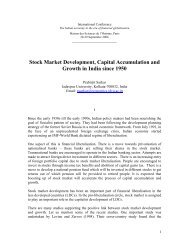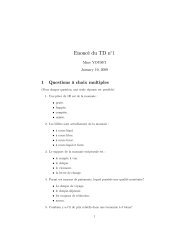Does the Entry Mode of Foreign Banks Matter for Bank ... - EconomiX
Does the Entry Mode of Foreign Banks Matter for Bank ... - EconomiX
Does the Entry Mode of Foreign Banks Matter for Bank ... - EconomiX
You also want an ePaper? Increase the reach of your titles
YUMPU automatically turns print PDFs into web optimized ePapers that Google loves.
Working over an extended period running from 1993 to 1998, Hasan & Marton(2003) compute cost and pr<strong>of</strong>it efficiencies <strong>for</strong> banks in Hungary, using stochasticfrontier analysis and report that domestic banks are less cost- and pr<strong>of</strong>it-efficient thanthose with <strong>for</strong>eign participation. Fur<strong>the</strong>rmore, <strong>the</strong>y divide <strong>for</strong>eign banks into four groupsbased on <strong>the</strong> extent <strong>of</strong> <strong>for</strong>eign involvement, and find that <strong>the</strong> higher <strong>the</strong> <strong>for</strong>eignparticipation, <strong>the</strong> higher <strong>the</strong> efficiency. Finally, <strong>the</strong> average inefficiency scores <strong>of</strong> allbanks exhibit a significant improvement over <strong>the</strong> sample years both in cost and pr<strong>of</strong>its.(Matousek & Taci, 2004) estimates cost efficiency <strong>for</strong> Czech banks from 1993 to1998 using Distribution Free Approach. The results show that on average, <strong>for</strong>eign banksare more cost-efficient than domestic banks, though <strong>the</strong>ir efficiency is similar to that <strong>of</strong>“good” small private domestic banks in <strong>the</strong>ir first years <strong>of</strong> existence.Havrylchyk (2006) also reports <strong>the</strong> superior per<strong>for</strong>mance <strong>of</strong> <strong>for</strong>eign banks <strong>for</strong>Poland using Data Envelopment Analysis. However, over <strong>the</strong> period under study - 1997to 2001, she finds that <strong>the</strong> efficiency <strong>of</strong> both <strong>for</strong>eign and domestic banks appears to havedeteriorated on average.This literature suffers from a main drawback. Indeed, although taking intoaccount various discriminating criteria amongst <strong>for</strong>eign banks such as levels <strong>of</strong> <strong>for</strong>eigninvolvement in bank ownership, types <strong>of</strong> <strong>for</strong>eign owners (strategic partners, institutionalinvestors…) or countries <strong>of</strong> origin <strong>of</strong> <strong>for</strong>eign banks, few studies have taken into account<strong>the</strong>ir modes <strong>of</strong> entry. A likely reason <strong>for</strong> this deficit is <strong>the</strong> difficulty in tracking evolutionin bank ownership over time.Recent studies have attempted to bridge this gap but have not focused on bankefficiency per se. For instance, (Claeys & Hainz, 2006) investigates <strong>the</strong> impact <strong>of</strong> entrymodes <strong>of</strong> <strong>for</strong>eign banks on <strong>the</strong> degree <strong>of</strong> competition in <strong>the</strong> local banking markets, andconsequently on banks’ lending rates. Their results show that competition is strongerwhen market entry occurs through greenfield investments, which will cut down domesticbanks’ interest rates. (Haas & Lelyveld, 2006) studies credit behavior <strong>of</strong> <strong>for</strong>eign anddomestic banks in Central and Eastern Europe from 1993-2000, and finds that duringcrisis periods, domestic banks contracted <strong>the</strong>ir credit base, whereas greenfield banks didnot. Moreover, <strong>the</strong> credit behavior <strong>of</strong> greenfield institutions depends negatively on <strong>the</strong>ir-5-




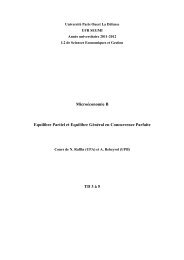

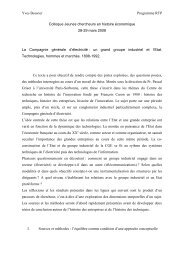

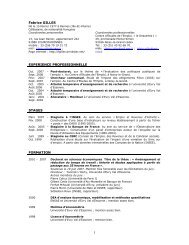
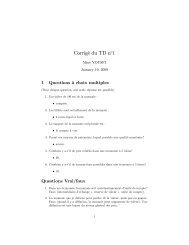
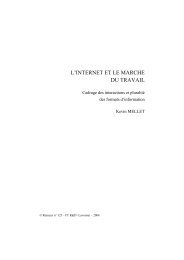
![P * 1 JTZWL_TZY OP^ Sd[Z_Sl^P^ !=m_m]Z^NmOL ... - EconomiX](https://img.yumpu.com/42226403/1/190x143/p-1-jtzwl-tzy-op-sdz-slp-m-mznmol-economix.jpg?quality=85)
